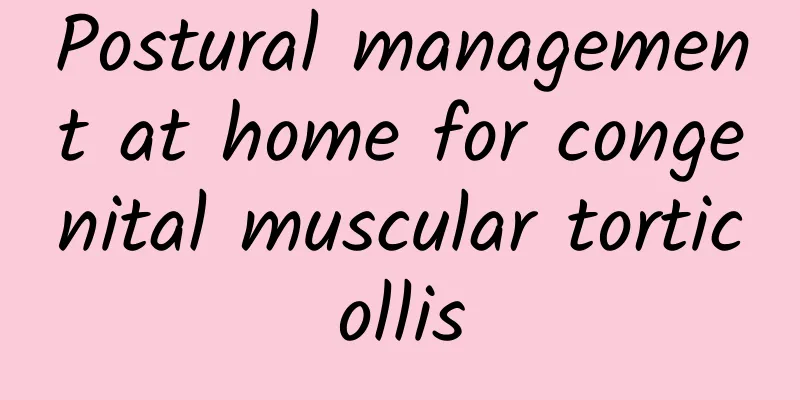Postural management at home for congenital muscular torticollis

|
Congenital muscular torticollis is a common benign disease of the bone, joint and musculoskeletal system in children. Its types include: 1. Mass type : manifested as a mass in the sternocleidomastoid muscle on the affected side and limited active and passive joint range of motion of the neck. 2. Muscle tension type : manifested by obvious tension, contracture and cord-like shape of the sternocleidomastoid muscle on the affected side, and limited range of motion of the neck joint. 3. Postural type : The child only has symptoms of head tilt, but no sternocleidomastoid muscle mass, muscle tension, or limited passive joint movement. Babies with congenital muscular torticollis will have facial asymmetry, which affects their appearance. Long-term weight bearing on one side during sleep will cause tilted head. The eyes are not at the same level, which may cause secondary strabismus. The poor appearance caused by secondary deformity will have a negative impact on their psychological development as they grow older. Therefore, in response to the above-mentioned hazards, in addition to regular outpatient treatment, we also need parents to actively cooperate with posture management at home. Let’s learn together with the editor. 1. When the mother is breastfeeding, she can guide the baby's head to rotate toward the affected side. (Breastfeeding in the direction of the affected side) 2. When sleeping in the prone position, turn the head to the affected side and align the lower jaw with the shoulder on the affected side. Note that when managing the prone position, parents must pay 100% attention to ensure that the baby breathes smoothly. 3. Use visual and auditory stimulation and safe sound, light and electrical toys to gently guide the child to raise his head and rotate his head toward the affected side. 4. Inclined holding position: This holding position can train the strength of the healthy side's neck muscles, promote the development of the neck upright reflex, and correct abnormal posture. The child leans on the parent's back, one hand passes through the child's legs to the waist, and the other hand is wrapped around the chest, slowly tilting the trunk to the affected side, guiding the child's neck to actively move to the healthy side. The popular science content of this platform has been funded by the China Association for Science and Technology's Science Popularization Department's 2022 National Science Literacy Action Project "National Society Science Popularization Capacity Improvement Project-Rehabilitation Science Popularization Service Capacity Improvement Action Plan" |
<<: Rehabilitation treatment for lumbar disc herniation
>>: If you sprain your ankle repeatedly, be careful of chronic ankle instability!
Recommend
What do the amniotic fluid dark area and amniotic fluid index mean?
Amniotic fluid is for the survival of the fetus, ...
Do children only have stuffy noses, runny noses, and sneezing when they have a cold? That may not be the case...
gossip In spring, if children repeatedly experien...
The Spring Festival is a high incidence period of "food poisoning", so be sure to pay attention!
The custom of celebrating the Spring Festival in ...
Early symptoms of hyperthyroidism in women
Hyperthyroidism, which is what we usually call &q...
Wearing black underwear makes you more likely to get cancer? The truth behind "Don't buy black underwear" is revealed
Black is one of the most common colors in textile...
Will I have miscarriage if I am more than four months pregnant?
Pregnancy is a very happy thing for women, but pr...
Can seborrheic alopecia in young women be cured?
Hair loss is not just a problem for middle-aged a...
You can take ultrasound during menstruation. Here is the correct way to do it.
Many women worry about the impact on B-ultrasound...
Rumor debunked: If you cup a cup after getting the vaccine, will the vaccine be a hundred times more effective?
Rumor has it: The United States has discovered a ...
What causes stomach discomfort in pregnant women?
After a woman becomes pregnant, the hormones in h...
Vulva is a little itchy
Many women often suffer from vulvar itching. Once...
How to recover from pelvic relaxation
Pelvic relaxation is often related to childbirth....
How to regulate female uterine cold
Uterine cold is a common symptom for women. Gener...
Menstrual blood is black
During menstruation, many women experience irregu...









